Mechanism Analysis of the Strong Coastal Current Zone and Abrupt Strong–Current Phenomena in Spring and Summer in the Yangjiang Sea Area of Western Guangdong in the Northwest of the South China Sea
Abstract
1. Introduction
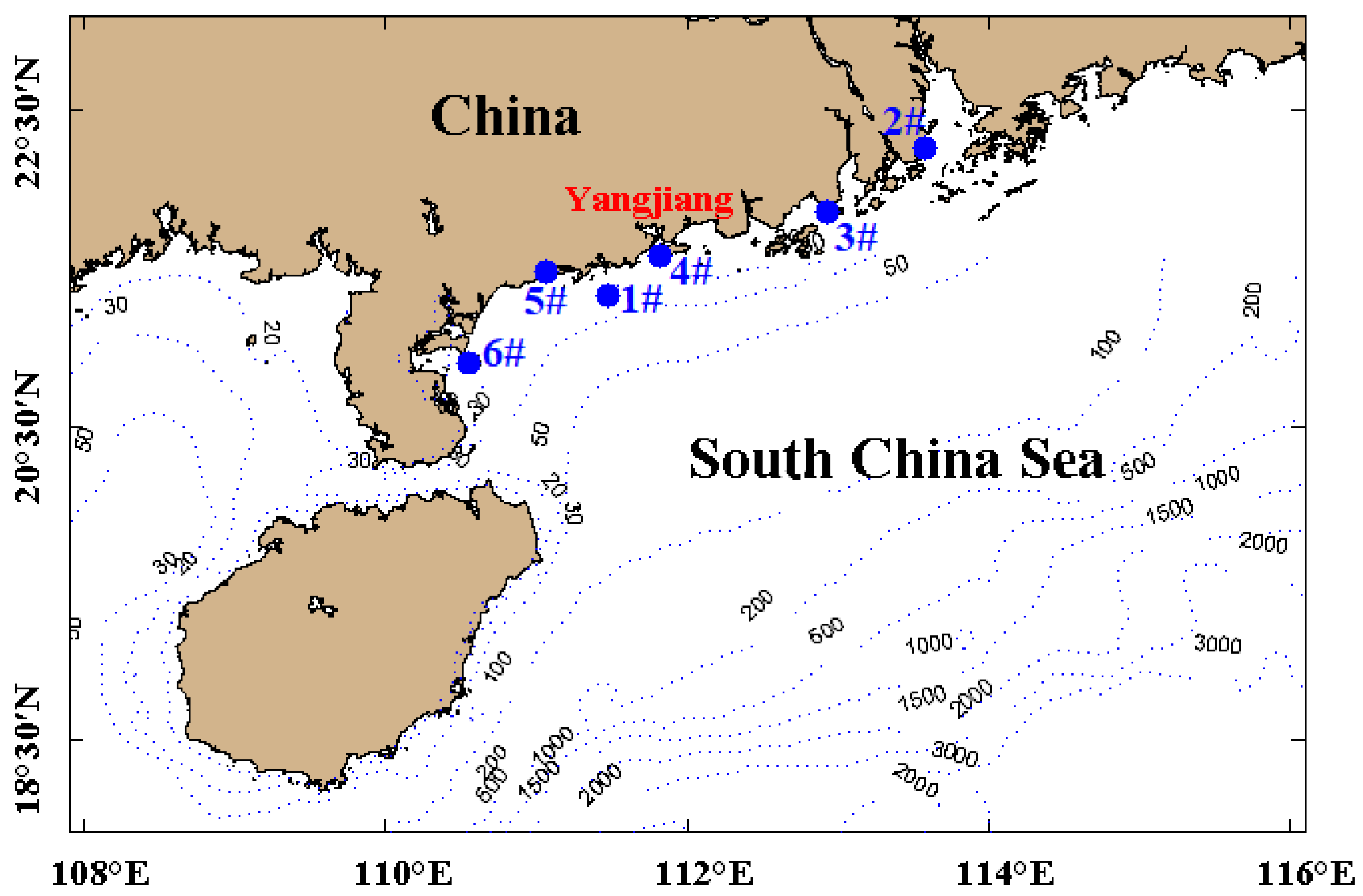
| Name of the Station | Observation Factors | Observation Time |
|---|---|---|
| Station 1 | sea current, water level | 1 October 2018~30 September 2019 |
| Station 2 | salinity, water level | 1 March 2019~31 August 2019 |
| Station 3 | salinity | 1 March 2019~31 August 2019 |
| Station 4 | wind, salinity, water level | 1 March 2019~31 August 2019 |
| Station 5 | salinity, water level | 1 March 2019~31 August 2019 |
| Station 6 | salinity, water level | 1 March 2019~31 August 2019 |
2. Data Resource
2.1. Observation of One-Day Period Sea Currents in Multiple Voyages
2.2. Coastal Continuous Hydrology Climate Observation
3. Coastal Strong–Current Zone in the Yangjiang Sea Area
3.1. Location of the Strong–Current Zone in the Yangjiang Sea Area
3.2. Analysis of Residual Current in the Strong–Current Zone during the Observation Period of the First Voyage
4. Seasonal Variation Features of the Coastal Current in the Yangjiang Sea Area
5. Abrupt Strong–Current Phenomena in the Yangjiang Sea Area in Spring and Summer
6. Hydrodynamic Characteristics and Influence Mechanism of Westward Current in the Coastal Sea Area of Western Guangdong
6.1. Maximum Monthly Surface Current Velocity at Station 1
6.2. Time Variation of Sea Current in Spring and Summer at Station 1#
6.3. Strong–Current Phenomenon Dynamic Mechanism Analysis
7. Conclusions
Author Contributions
Funding
Institutional Review Board Statement
Informed Consent Statement
Data Availability Statement
Conflicts of Interest
References
- Chen, Y.Z.; Cao, Y.G.; Liao, S.Z.; Ma, Y.; Liu, Y.Q.; Ouyang, Y.Z.; Xiang, R. Observational Analysis of the Formation Reasons and Evolution Law of Winter Counter-Wind Current in Jiazi Sea Area of Northeastern South China Sea. J. Mar. Sci. Eng. 2022, 10, 893. [Google Scholar] [CrossRef]
- Hu, J.Y.; Kawamura, H.; Hong, H.S.; Qi, Y. A review on currents in the South China Sea: Seasonal circulation, South China Sea Warm Current and Kuroshio intrusion. J. Oceanogr. 2000, 56, 607–624. [Google Scholar] [CrossRef]
- Wu, B.Y. A study on the circulation in shelf waters west to Pearl River Mouth Ⅲ. Shelf circulation model. J. Oceanogr. Taiwan Strait 1990, 9, 118–126. [Google Scholar]
- Ying, Z.F. On the coast current and its deposit along western coast in Guangdong. Acta Sci. Natualium Univ. Sunyatseni 1999, 38, 85–89. [Google Scholar]
- Yang, S.Y.; Bao, X.W.; Chen, C.S.; Chen, F. Analysis on characteristics and mechanism of current system in west coast of Guangdong Province in the summer. Haiyang Xuebao 2003, 25, 1–8. [Google Scholar]
- Yan, J.H.; Chen, D.S. The characteristics of low frequency currents in the area of Shuidong anchored floating whelf in the west of Guangdong coastal waters. Trans. Oceanol. Limnol. 2005, 3, 8–15. [Google Scholar]
- Xie, L.L.; Cao, R.X.; Shang, Q.T. Progress of study on coastal circulation near the shore of western Guangdong. J. Guangdong Ocean. Univ. 2012, 32, 94–98. [Google Scholar]
- Wong, L.A.; Chen, J.C.; Dong, L.X. A model of the plume front of the Pearl River Estuary, China and adjacent coastal waters in the winter dry season. Cont. Shelf Res. 2004, 24, 1779–1795. [Google Scholar] [CrossRef]
- Huang, R.X.; Du, Y. Scientific questions about South China Sea ocean dynamics. Acta Oceanol. Sin. 2015, 34, 1–5. [Google Scholar] [CrossRef]
- Chen, Y.; Cao, Y.; Luo, S.; Liao, S.; Deng, D.; Liu, Y.; Ma, Y. Mechanism analysis of alongshore shock current phenomenon in Yangjiang sea area along the coast of western Guangdong in spring and summer. Haiyang Xuebao 2022, 44, 1–11. [Google Scholar]
- Wang, H.; Liu, K.X.; Cao, Z.G.; Fan, W.J.; Liu, S.H.; Li, J. Characteristics and possible causes of the seasonal sea level anomaly along the South China Sea coast. Acta Oceanol. Sin. 2017, 36, 9–16. [Google Scholar] [CrossRef]
- Wong, L.A.; Chen, J.C.; Xue, H.; Dong, L.X.; Guan, W.B.; Su, J.L. A model study of the circulation in the Pearl River Estuary (PRE) and its adjacent coastal waters: 2. Sensitivity experiments. J. Geophys. Res. Ocean. 2003, 108, 3157. [Google Scholar] [CrossRef]
- Huang, X.L.; Jing, Z.Y.; Zheng, R.X.; Cao, H.J. Dynamical analysis of submesoscale fronts associated with wind-forced offshore jet in the western South China Sea. Acta Oceanol. Sin. 2020, 39, 1–12. [Google Scholar] [CrossRef]
- Xue, H.J.; Chai, F.; Xu, D.Y.; Shi, M.C. Characteristics and seasonal variation of the coastal currents in the South China Sea. Chin. Oceanogr. Anthol. 2001, 13, 64–75. [Google Scholar]
- Sun, Z.; Hu, J.; Lin, H.; Chen, Z.; Zhu, J.; Yang, L.; Hu, Z.; Chen, X.; Wu, X. Lagrangian Observation of the Kuroshio Current by Surface Drifters in 2019. J. Mar. Sci. Eng. 2022, 10, 1027. [Google Scholar] [CrossRef]
- Stewart, R.H. Introduction to Physical Oceanography; Department of Oceanography; Texas A&M University: College Station, TX, USA, 2003; pp. 135–150. [Google Scholar]
- Ou, S.Y.; Zhang, H.; Wang, D.X. Dynamics of the buoyant plume off the Pearl River Estuary in summer. Environ. Fluid Mech. 2009, 9, 471–492. [Google Scholar] [CrossRef]
- Li, R.X.; Chen, C.S.; Xia, H.Y.; Beardsley, R.C.; Shi, M.C.; Lai, Z.G.; Lin, H.C.; Feng, Y.Q.; Liu, C.J.; Xu, Q.C.; et al. Observed wintertime tidal and subtidal currents over the continental shelf in the northern South China Sea. J. Geophys. Res. Ocean. 2014, 119, 5289–5310. [Google Scholar] [CrossRef]
- Cao, Y.G.; Feng, Y.Q.; Ouyang, Y.Z.; Chen, Y.Z.; Liao, S.Z.; Liu, T.M. Analysis of summer current characteristics in Yangjiang sea area of Westem Guangdong. Hydrograpjic Surv. Charting 2022, 42, 27–32. [Google Scholar]
- Hollister, C.D.; Mccave, I.N. Sedimentation under deep-sea storms. Nature 1984, 309, 220–225. [Google Scholar] [CrossRef]
- Xiu, R.C.; Zhang, Z.L.; Liu, A.J. Observational experiment, analysis and discussion of sea storm current. Haiyang Xuebao 2004, 26, 118–124. [Google Scholar]
- Liu, C.J.; Xia, H.Y.; Wang, D.X. The observation and analysis of eastern Guangdong coastal downwelling in the winter of 2006. Acta Oceanol. Sin. 2010, 32, 1–9. [Google Scholar]

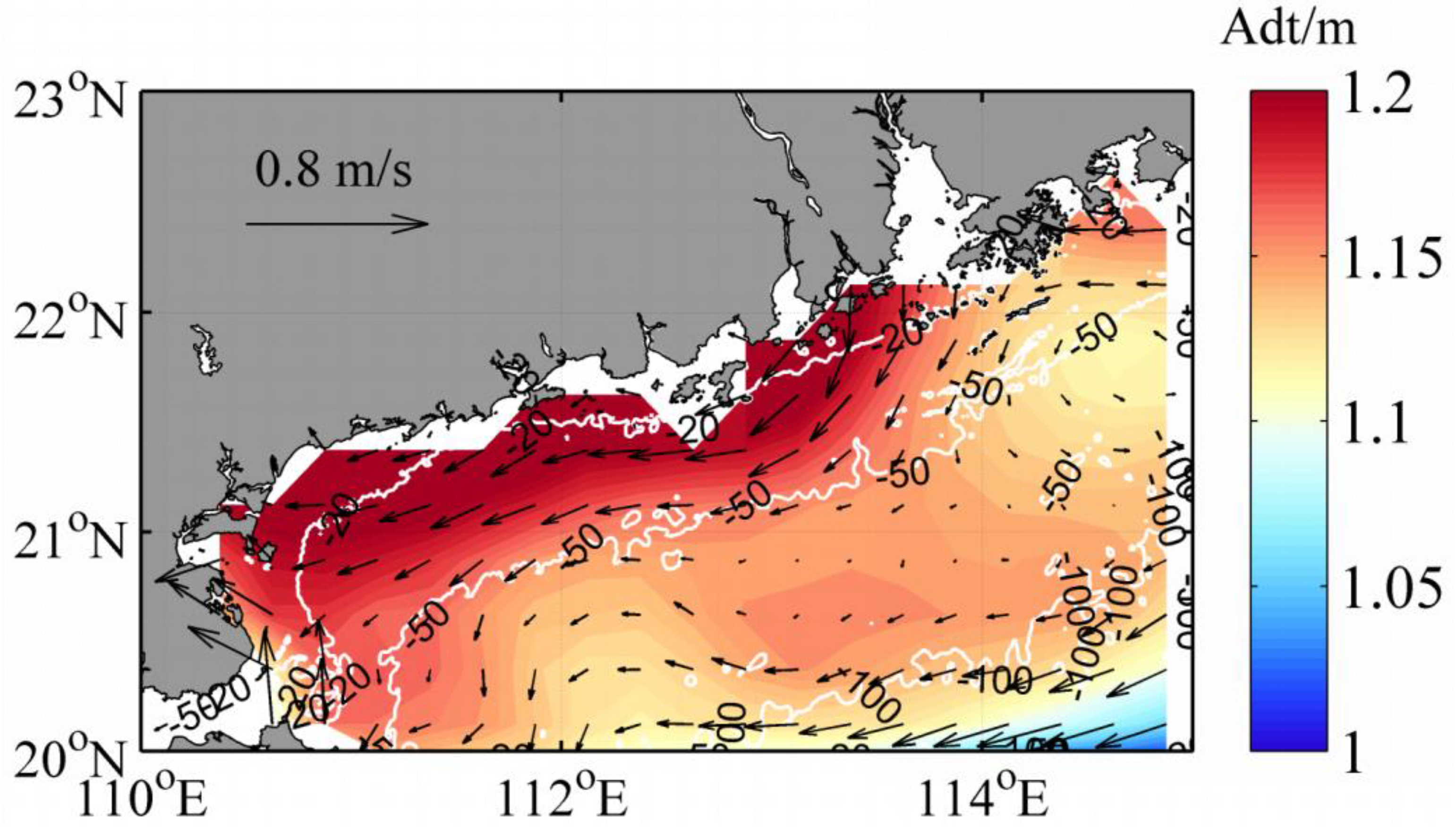
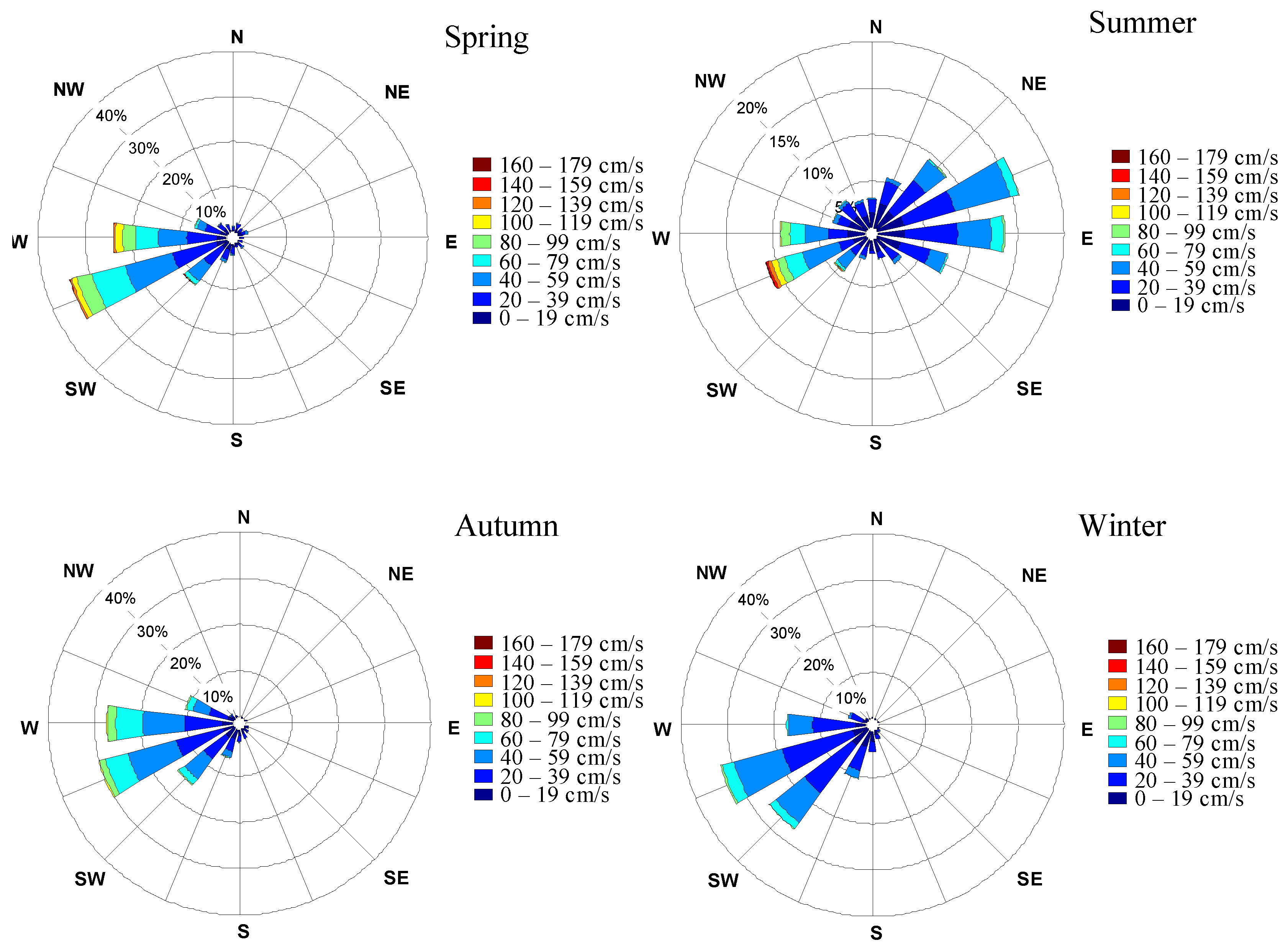

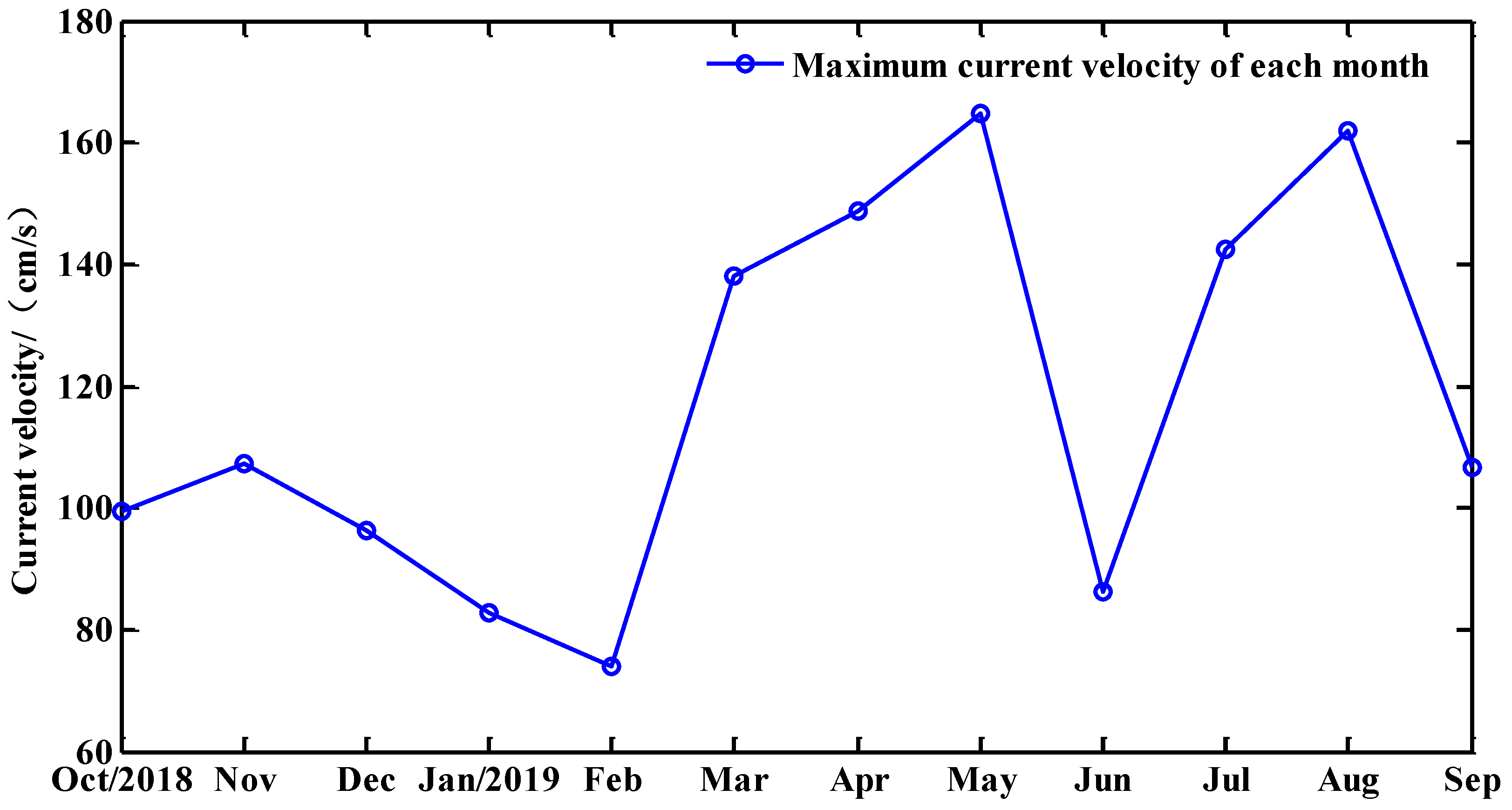
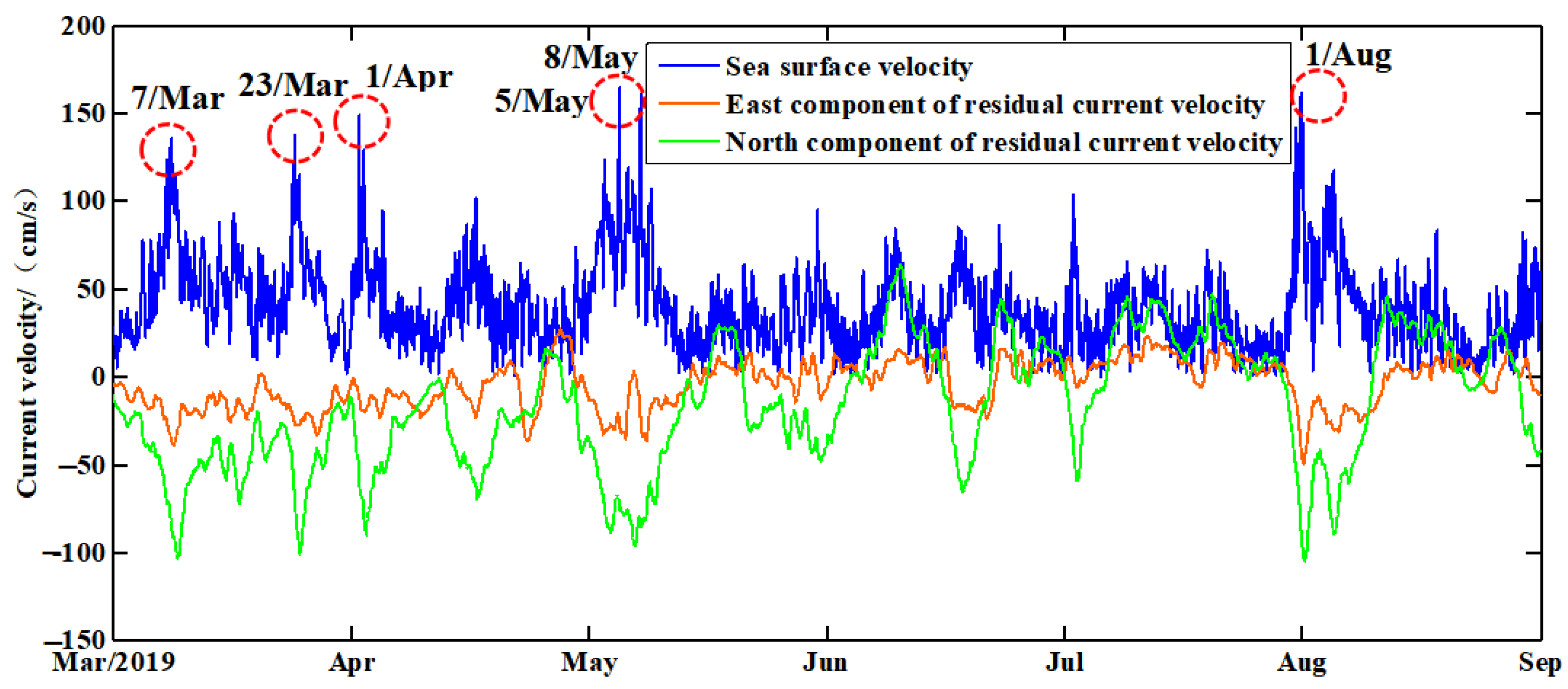

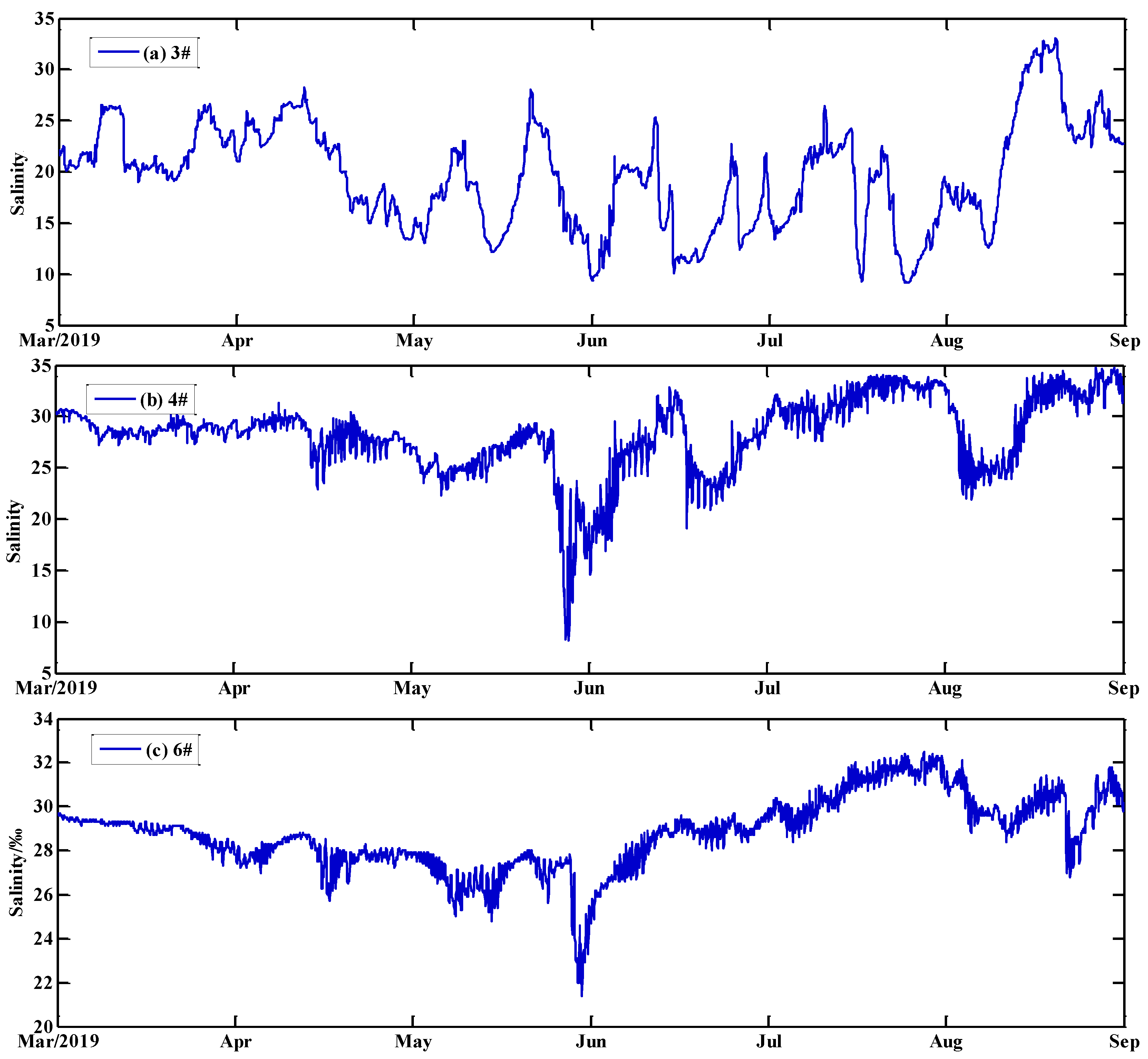

| Voyage | Observation Date | Number of Stations | Range of Water Level |
|---|---|---|---|
| 1 | 4:00 on 14 July 2018~5:00 on 15 July 2018 | 10 | 22 m to 29 m |
| 2 | 7:00 on 5 December 2018~8:00 on 6 December 2018 | 9 | 23 m to 34 m |
| 3 | 6:00 on 26 April 2020~7:00 on 27 April 2020 | 10 | 8 m to 45 m |
| 4 | 13:00 on 12 August 2022~14:00 on 13 August 2022 | 10 | 6 m to 28 m |
Disclaimer/Publisher’s Note: The statements, opinions and data contained in all publications are solely those of the individual author(s) and contributor(s) and not of MDPI and/or the editor(s). MDPI and/or the editor(s) disclaim responsibility for any injury to people or property resulting from any ideas, methods, instructions or products referred to in the content. |
© 2023 by the authors. Licensee MDPI, Basel, Switzerland. This article is an open access article distributed under the terms and conditions of the Creative Commons Attribution (CC BY) license (https://creativecommons.org/licenses/by/4.0/).
Share and Cite
Chen, Y.; Cao, Y.; Feng, Y.; Ma, Y.; Luo, S.; Wang, W.; Ouyang, Y.; Liu, Y.; Liu, C.; Liao, S.; et al. Mechanism Analysis of the Strong Coastal Current Zone and Abrupt Strong–Current Phenomena in Spring and Summer in the Yangjiang Sea Area of Western Guangdong in the Northwest of the South China Sea. J. Mar. Sci. Eng. 2023, 11, 999. https://doi.org/10.3390/jmse11050999
Chen Y, Cao Y, Feng Y, Ma Y, Luo S, Wang W, Ouyang Y, Liu Y, Liu C, Liao S, et al. Mechanism Analysis of the Strong Coastal Current Zone and Abrupt Strong–Current Phenomena in Spring and Summer in the Yangjiang Sea Area of Western Guangdong in the Northwest of the South China Sea. Journal of Marine Science and Engineering. 2023; 11(5):999. https://doi.org/10.3390/jmse11050999
Chicago/Turabian StyleChen, Yizhan, Yonggang Cao, Yanqing Feng, Yuan Ma, Shihao Luo, Weiping Wang, Yongzhong Ouyang, Yuqiang Liu, Changjian Liu, Shizhi Liao, and et al. 2023. "Mechanism Analysis of the Strong Coastal Current Zone and Abrupt Strong–Current Phenomena in Spring and Summer in the Yangjiang Sea Area of Western Guangdong in the Northwest of the South China Sea" Journal of Marine Science and Engineering 11, no. 5: 999. https://doi.org/10.3390/jmse11050999
APA StyleChen, Y., Cao, Y., Feng, Y., Ma, Y., Luo, S., Wang, W., Ouyang, Y., Liu, Y., Liu, C., Liao, S., & Xiao, Z. (2023). Mechanism Analysis of the Strong Coastal Current Zone and Abrupt Strong–Current Phenomena in Spring and Summer in the Yangjiang Sea Area of Western Guangdong in the Northwest of the South China Sea. Journal of Marine Science and Engineering, 11(5), 999. https://doi.org/10.3390/jmse11050999





